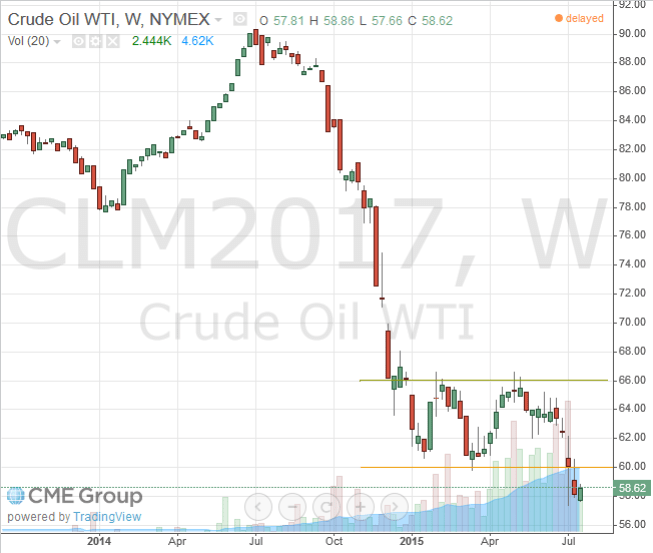Bloomberg News quotes Zhu Jimin, deputy head of the China Iron & Steel Association, representing major steel producers, at their quarterly briefing on Wednesday:
“Production cuts are slower than the contraction in demand, therefore oversupply is worsening.”
“China’s steel demand evaporated at unprecedented speed as the nation’s economic growth slowed,” Zhu said. “As demand quickly contracted, steel mills are lowering prices in competition to get contracts.”
Little wonder that bulk commodity prices are falling sharply.

Australian producers have been ramping up production to compensate for lower prices.

But with further production due to come on line, the market looks ready for a meltdown. This from David Llewellyn-Smith at Macrobusiness:
Yes, China is still shutting in supply and is on track for 270 million tonnes this year but it’s not going to drop enough in the future (at the very best down to 200mt) as Roy Hill, Sino, Anglo, Vale and India (and possibly Tonkolili as well) continue the great ramp up, adding another 200mt plus in the next two years even as Chinese steel production keeps falling at 2-3% per year, taking 40mt per annum out of demand….. the total seaborne iron ore market is about to peak and then shrink….
The ASX 300 Metals & Mining Index is testing its 2008 low. Breach appears likely and would offer a target of 1700*.

* Target calculation: 2200 – ( 2700 – 2200 ) = 1700
North America
The S&P 500 respected support at 2050 and is headed for a test of the previous high at 2130 on the back of strong earnings performance. Rising 21-day Twiggs Money Flow indicates medium-term buying pressure but expect strong resistance at 2130. Reversal below 2050 is unlikely, but would warn of another test of primary support at 1870.

* Target calculation: 2000 + ( 2000 – 1870 ) = 2130
A declining CBOE Volatility Index (VIX) indicates market risk is easing.

NYSE short sales remain subdued.

Dow Jones Industrial Average is similarly headed for a test of 18300, with 13-week Twiggs Money Flow rising steeply.

Canada’s TSX 60 continues to test stubborn resistance at 825. Weak 13-week Twiggs Momentum, below zero, indicates the market remains bearish. Breakout would signal an advance to 900, but reversal below the former primary support level at 800 is as likely and would warn of another decline.

* Target calculation: 775 – ( 825 – 775 ) = 725
Europe
Germany’s DAX is testing resistance at 11000. Recovery of 13-week Twiggs Money Flow above zero indicates medium-term buying pressure. Breakout above the descending trendline would suggest another test of the previous high at 12400. Expect stubborn resistance, however, and reversal below 10000 would warn of another decline.

The Footsie is similarly testing resistance at 6500. Breakout above the descending trendline would suggest another test of the previous high at 7100. 13-Week Twiggs Money Flow troughs above zero indicate long-term buying pressure. Reversal below 6250 is unlikely, but would warn of another test of primary support at 6000.

Asia
The Shanghai Composite Index continues to test resistance at 3500. Respect is likely and would indicate a re-test of government-backed support at 3000.

Hong Kong’s Hang Seng Index is retracing to test support at 22500. Respect would indicate a rally to 24000, but failure remains as likely and would test primary support at 21000. A 13-week Twiggs Money Flow trough above zero would indicate (long-term) buying pressure.

Japan’s Nikkei 225 is testing resistance at 19000. Breakout would signal another test of 21000. Respect is less likely, but would warn of another test of primary support at 17000.

* Target calculation: 19000 + ( 19000 – 17000 ) = 21000
India’s Sensex encountered resistance at 27500. Rising 13-week Twiggs Money Flow troughs above zero indicate long-term buyiong pressure. Expect another test of 26500 but respect is likely and would indicate continuation of the rally. Reversal below 26500 would warn of another (primary) decline.

* Target calculation: 25000 – ( 27500 – 25000 ) = 22500
Australia
The ASX 200 is retracing to test medium-term support between 5200 and 5300. Reversal of 21-day Twiggs Money Flow below its rising trendline indicates (medium-term) selling pressure; decline below zero would strengthen the signal. Breach of 5200 would warn of another test of primary support at 5000. Recovery above the descending trendline is unlikely at this stage, but would suggest another test of 6000.

* Target calculation: 5000 – ( 5400 – 5000 ) = 4600



























